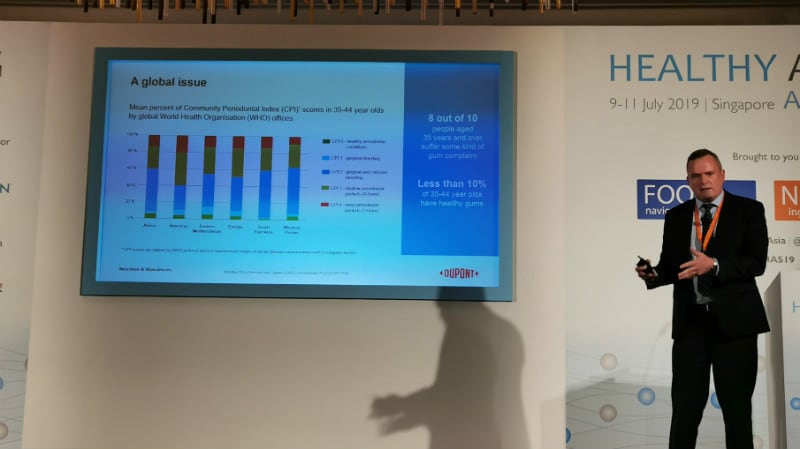According to DuPont Principal Application Specialist Anders Henriksson, this is especially important for the elderly population as the prevalence of periodontitis has been found to significantly increase in older age and has also been linked with other forms of disease.
“Oral biofilms are formed by bacterial communities [living in] saliva-covered [tissues], and are associated with infectious diseases such as tooth decay and periodontal disease, [which can in turn] lead to other serious health complications,” he told the audience at our recent Healthy Ageing APAC Summit 2019 in Singapore.
“Periodontal disease has previously also been linked to non-communicable diseases such as diabetes, coronary heart disease, rheumatoid arthritis, cancers and more.
“Based on the osteoimmunology of periodontal disease, we have found that probiotics can be used to drive the [profile of the microbiota in oral biofilms] towards a healthier state.”
Across both animal studies and human clinical trials, the application of probiotics was found to bring multiple positive effects for oral health, including a decrease in pro-inflammatory markers, a shift towards healthier oral microflora, and reduction in bleeding and periodontal pocket formation.
“Probiotics has the greatest role to play when used together with the traditional therapies of scaling (cleaning plaque and tartar from the gum line) and root planing (scraping and smoothing the tooth root surface to allow better reattachment of gum tissue,” said Henriksson.
“The probiotics should be consumed after both of these treatments are applied.”
Study specifics
In all the studies that Henriksson presented on, the strain of probiotics tested was Bifidobacterium lactis HN019.
Two of these were animal studies, which were conducted on 32 rats and experimental groups were given one billion CFU per 10ml of the probiotics for 15 days.
The first study did not involve scaling and root planning treatments, but probiotic administration alone was already found to show benefits including reduced inflammatory marker levels and increased protective factors, along with a shift towards a healthier biofilm profile.
When scaling and root planning was administered before the probiotics in the second study, the benefits were found to be even more profound, with much higher levels of good bacteria seen in the biofilm as well as improvements to bone volume and decreases in bone porosity.
“This showed that the probiotics can modulate a change in the inflammatory markers that ultimately lead to periodontal disease, hence are beneficial [for oral health and treatment],” said Henriksson.
The human clinical trials saw 41 adults with existing periodontitis separated into two groups, with one group administered a placebo and the other a lozenge containing one billion CFU per 10ml of Bifidobacterium lactis HN019 for 30 days.
All subjects were given scaling and root planning treatment, and follow-ups were conducted after 30 days and 90 days from start of treatment.
The researchers found that at the 90-day point, which would be 60 days after the last administered dosage of probiotics, subjects still exhibited the strain in their oral cavity.
This finding presented along with other clinical benefits such as improvements in Clinical Attachment Loss (destruction of support around a tooth), Probing Pocket Depth (gaps created between the gum and tooth when gum attachment weakens and pulls away), and a significant and continuously stable decrease in disease-causing organisms.
“Even after probiotics administration stopped, the levels of disease-causing bacteria like P. gingivalis did not increase [to pre-treatment levels] even 60 days later at the 90-day point, meaning that recolonisation of the harmful bacteria did not occur,” said Henriksson.
Delivery format options
Probiotics can be delivered to the patients via several formats, including food, tablets and toothpaste.
“We have not yet determined how long the probiotics need to be present in the mouth for best effect, but I would say that at least a few minutes of contact time would be necessary in order to ensure it has the opportunity to attach to the biofilm,” added Henriksson.
All in all, patient healing was observed to be ‘much improved’ after including the use of probiotics for treatment.
“This is also expected to lower the costs associated with treatment,” he claimed.


